Related Research Articles
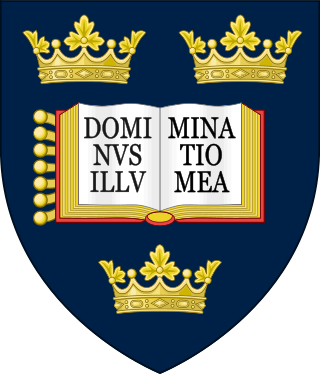
The University of Oxford is a collegiate research university in Oxford, England. There is evidence of teaching as early as 1096, making it the oldest university in the English-speaking world and the world's second-oldest university in continuous operation. It grew rapidly from 1167, when Henry II banned English students from attending the University of Paris. After disputes between students and Oxford townsfolk in 1209, some academics fled north-east to Cambridge where they established what became the University of Cambridge. The two English ancient universities share many common features and are jointly referred to as Oxbridge.

Somerville College, a constituent college of the University of Oxford in England, was founded in 1879 as Somerville Hall, one of its first two women's colleges. Among its alumnae have been Margaret Thatcher, Indira Gandhi, Dorothy Hodgkin, Iris Murdoch, Vera Brittain and Dorothy L. Sayers. It began admitting men in 1994. Its library is one of Oxford's largest college libraries. The college's liberal tone derives from its founding by social liberals, as Oxford's first non-denominational college for women, unlike the Anglican Lady Margaret Hall, the other to open that year. In 1964, it was among the first to cease locking up at night to stop students staying out late. No gowns are worn at formal halls.
Blackfriars Priory is a Dominican religious community in Oxford, England. Its primary work is the administration of two educational institutions: Blackfriars Studium, a centre of theological studies in the Roman Catholic tradition; and Blackfriars Hall, a constituent permanent private hall of the University of Oxford. The current prior of Blackfriars is Nicholas Crowe. The name Blackfriars is commonly used in Britain to denote a house of Dominican friars, a reference to their black cappa, which forms part of their habit.

Campion Hall is one of the four permanent private halls of the University of Oxford in England. A Catholic hall, it is run by the Society of Jesus and named after Edmund Campion, a martyr and fellow of St John's College, Oxford. The hall is located on Brewer Street, between Christ Church and Pembroke College. The buildings, along with many of the fixtures and fittings, were designed by Sir Edwin Lutyens, his only buildings in Oxford. The hall also houses an extensive collection of religious art spanning 600 years; the pieces were collected primarily by Fr Martin D'Arcy in the 1930s.

St Benet's Hall was a permanent private hall (PPH) of the University of Oxford, originally a Roman Catholic religious house of studies. It closed in 2022. The principal building was located at the northern end of St Giles' on its western side, close to the junction with Woodstock Road, Oxford.
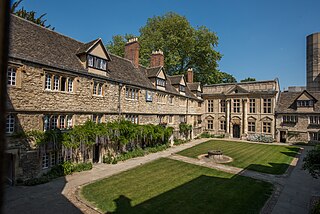
St Edmund Hall is a constituent college of the University of Oxford. The college claims to be "the oldest surviving academic society to house and educate undergraduates in any university" and was the last surviving medieval academic hall at the university.
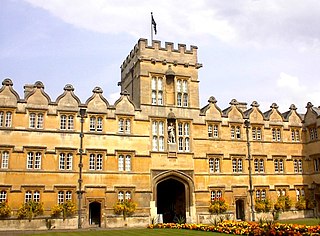
University College, formally The College of the Great Hall of the University of Oxford and colloquially referred to as "Univ", is a constituent college of the University of Oxford in England. It has a claim to being the oldest college of the university, having been founded in 1249 by William of Durham.
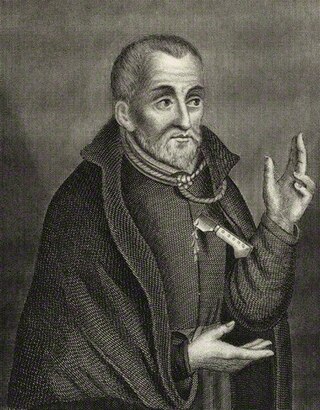
Edmund Campion, SJ was an English Jesuit priest and martyr. While conducting an underground ministry in officially Anglican England, Campion was arrested by priest hunters. Convicted of high treason, he was hanged, drawn and quartered at Tyburn. Campion was beatified by Pope Leo XIII in 1886 and canonised in 1970 by Pope Paul VI as one of the Forty Martyrs of England and Wales. His feast day is celebrated on 1 December.
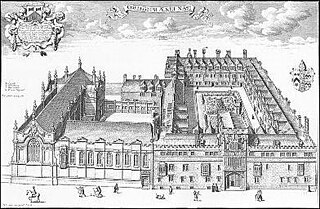
The University of Oxford has thirty-nine colleges, and four permanent private halls (PPHs) of religious foundation. Colleges and PPHs are autonomous self-governing corporations within the university. These colleges are not only houses of residence, but have substantial responsibility for teaching undergraduate students. Generally tutorials and classes are the responsibility of colleges, while lectures, examinations, laboratories, and the central library are run by the university. Students normally have most of their tutorials in their own college, but often have a couple of modules taught at other colleges or even at faculties and departments. Most colleges take both graduates and undergraduates, but several are for graduates only.
A permanent private hall (PPH) in the University of Oxford is an educational institution within the university. There are four permanent private halls at Oxford, three of which admit undergraduates. They were founded by different Christian denominations. PPHs principally differ from colleges in the sense that the latter are governed by the fellows of the college, whereas the governance of a PPH fully or partially rests with the corresponding Christian denomination.

St Mary Hall was a medieval academic hall of the University of Oxford. It was associated with Oriel College from 1326 to 1545, but functioned independently from 1545 until it was re-incorporated into Oriel College in 1902.
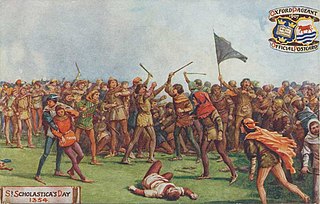
The St Scholastica Day riot took place in Oxford, England, on 10 February 1355, Saint Scholastica's Day. The disturbance began when two students from the University of Oxford complained about the quality of wine served to them in the Swindlestock Tavern, which stood on Carfax, in the centre of the town. The students quarrelled with the taverner; the argument quickly escalated to blows. The inn's customers joined in on both sides, and the resulting melee turned into a riot. The violence started by the bar brawl continued over three days, with armed gangs coming in from the countryside to assist the townspeople. University halls and students' accommodation were raided and the inhabitants murdered; there were some reports of clerics being scalped. Around 30 townsfolk were killed, as were up to 63 members of the university.
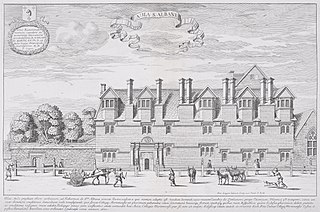
St Alban Hall, sometimes known as St Alban's Hall or Stubbins, was one of the medieval halls of the University of Oxford, and one of the longest-surviving. It was established in the 13th century, acquired by neighbouring Merton College in the 16th century but operated separately until the institutions merged in the late 19th century. The site in Merton Street, Oxford, is now occupied by Merton's Edwardian St Alban's Quad.
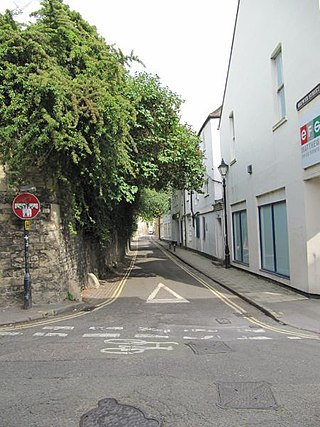
Brewer Street is a historic narrow street in central Oxford, England, south of Carfax. The street runs east–west, connecting with St Aldate's to the east and St Ebbe's Street to the west.
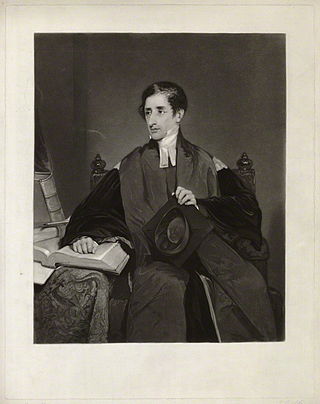
Richard Lynch Cotton was a British vicar and academic administrator at the University of Oxford.
Charsley's Hall was a private hall of the University of Oxford. After 1891 it was renamed as Marcon's Hall.
Edward Bernard Green OSB was an English Catholic priest, Benedictine monk of Ampleforth Abbey, and historian.

The following is a timeline of the history of the city, university and colleges of Oxford, England.
The Association for the Education of Women or Association for Promoting the Higher Education of Women in Oxford (AEW) was formed in 1878 to promote the education of women at the University of Oxford. It provided lectures and tutorials for students at the four women's halls in Oxford, as well as for female students living at home or in lodgings and was dissolved in 1920 when women were admitted as members of the university.
The academic halls were educational institutions within the University of Oxford. The principal difference between a college and a hall was that whereas the former are governed by the fellows of the college, the halls were governed by their principals. Of over a hundred halls in the Middle Ages, only St Edmund Hall survived into the mid-20th century, becoming a college in 1957.
References
- 1 2 Brockliss 2016, pp. 349.
- ↑ Brockliss 2016, pp. 351.
- ↑ Brockliss 2016, pp. 353.
- ↑ Ward, W. R. (1965). Victorian Oxford. Routledge. pp. 202–203.
- 1 2 3 4 Hibbert, Christopher, ed. (1988). "Private halls". The Encyclopaedia of Oxford. Macmillan. pp. 337–338.
- ↑ Brockliss 2016, pp. 369–372.
- ↑ Rogers, Nicholas. Catholics in Cambridge. p. 262.
- ↑ Storey, Graham (2014). A Preface to Hopkins. Routledge. p. 194. ISBN 9781317896036 . Retrieved 6 January 2020.
- ↑ Nash, James (1999). "The New People of East Oxford: The Suburbanisation of Cowley, 1851-91" (PDF). Oxoniensia. 63: 140.
- ↑ Aldrich, Richard; Gordon, Peter (2016). "Butler, George (1819–1890)". Dictionary of British Educationists. Routledge. ISBN 9781317949312 . Retrieved 6 January 2020.
- 1 2 "Campion Hall". A History of the County of Oxford: Volume 3, the University of Oxford. Victoria County History. pp. 339–340. Retrieved 7 September 2018.
- ↑ "Grindle's Hall". Oxford University Gazette. Vol. 21. 1891. p. 559.
- 1 2 3 "St Benet's Hall". A History of the County of Oxford: Volume 3, the University of Oxford. Victoria County History. pp. 340–341. Retrieved 7 September 2018.
- ↑ Scotland, Nigel (2004). Evangelical Anglicans in a Revolutionary Age, 1789-1901. Carlisle: Paternoster. p. 257.
- 1 2 Brock & Curthoys 2000, pp. 120.